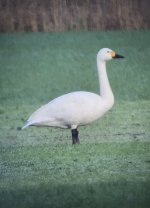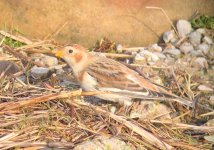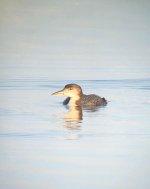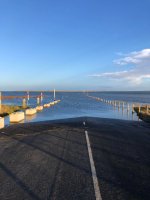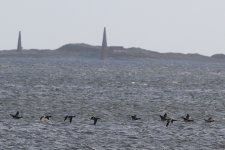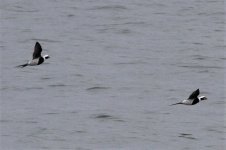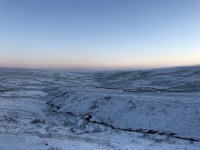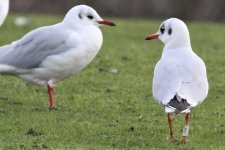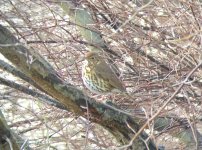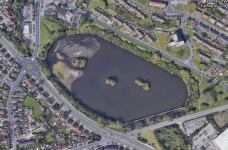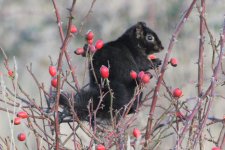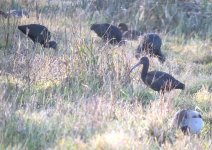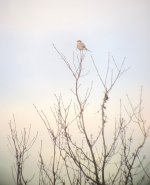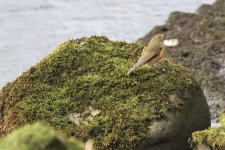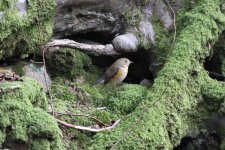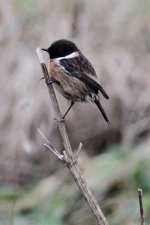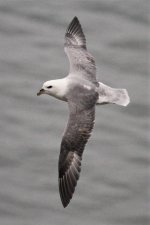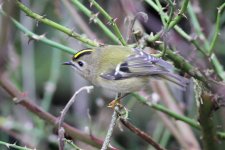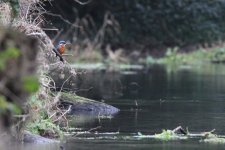1st January - Fylde Coast
2022 kicked off in traditional fashion for myself and my friend Ash, a birdrace around the Fylde Bird Club recording area to see how close to 100 species we could get. Only once out of four previous attempts had we hit this mark, setting a Fylde record of 106 species in 2020, with our other three totals falling in the 89-93 species range.
As in several previous years my first bird of 2022 was Robin, a pre-dawn singing individual on my street whilst I packed the car. As we drove towards the north-east corner of the Fylde more species became discernibe in the increasing light, including a herd of 70 Whooper Swans in the fields at Sand Villa as we passed, heading towards our first stop at Conder Pool. A Barn Owl hunting the grassland around the pool just as dawn was breaking was a great start as we started picking up wildfowl and wader species on the pool and adjacent estuary, a theme that continued just down the road at Glasson where 7 Goosander and 8 Goldeneye were on the basin and wader flocks circled the river on the rapidly incoming tide.
Carrying on towards Cockersand a scan of a large flock of gulls feeding in the roadside fields resulted in us unearthing a fine pair of Mediterranean Gulls (adult and 2nd winter), never an easy bird in the Fylde during the winter. Further along the lane we found that the main whooper swan herd had chosen one of the most innaccessible fields to feed in that day, but happily two of the accompanying adult Bewick's Swans were by themselves in a much easier to view location, species number 50 and it wasn't even 09:30!
At Cockersand itself the tide was now right in at the lighthouse, pushing the wildfowl close to the shore and the waders into the adjacent arable fields. Grey Plover, Eider and Pintail all hit the notebook as did four Brown Hares, my first mammal of the year. Down at the southern end of the site we located the wintering Snow Bunting feeding on the seawall, and we fortunate to flush two Jack Snipe from what was left of the marsh by the caravan park, always a tricky species to see so a good one to get under the belt early.
Leaving the coast behind we cut inland to Thurnham Hall to add some woodland species to the list, as well as a pair of Roe Deer, before heading to the farmland around Eagland Hill where a male Brambling was the highlight at the feeding station along with Yellowhammer and 21 Corn Bunting, the bird list now passing 85. Dipper at Brock, Bullfinch at Carr House Green Common and that ever tricky birdrace species Mistle Thrush followed at Newton Marsh, then it was onto Lytham Quays for the Ribble Marshes raptor fest where ringtail Hen Harrier, Merlin and Marsh Harrier were all bagged, albeit distantly.
We now only needed 8 more birds to hit the magic 100 mark, but it was now 14:30 and the light was already beginning to fade. Stanley Park was our penultimate port of call with Long-tailed Tit finally putting in an appearance along with Ring-necked Parakeet and Grey Squirrel. And so we headed for our final stop stop of the day, the viewing platform at Marton Mere, still 6 species short of target and looking likely to finish just short. Singing Cetti's Warbler and calling Water Rail were expected, but a pair of Goldcrests flitting through the adjacent scrub were a welcome addition, as was a Woodcock that gave superb views as it twice flew past us from its daytime roost just after 16:00. Like Mistle Thrush, Sparrowhawk is another birdrace enigma that can easily be missed, and that was looking to be the case until a big female cruised over the reedbed past the viewpoint, number 99! Scanning the distant barn roof drew a blank for the resident Little Owl, but all was not lost as at 16:10 one of the wintering Bittern took flight from the reedbed infront of us and gave prolonged views as it flew the whole length of the mere to the east end, species number 100 for the day! There was just enough time as we packed our scopes away to score the second wintering bittern that gave a brief flight view in the now near darkness. Driving out of the caravan park several Rabbits were seen on the grassy verges, making a combined total of 104 species to kick off the challenge, over a quarter of the way there already!
1. Robin
2. Blackbird
3. Carrion Crow
4. Pink-footed Goose
5. Herring Gull
6. Buzzard
7. Rook
8. Black-headed Gull
9. Whooper Swan
10. Mallard
11. Oystercatcher
12. Rock Dove
13. Wren
14. Redwing
15. Lapwing
16. Mute Swan
17. Shelduck
18. Tufted Duck
19. Moorhen
20. Greylag Goose
21. Curlew
22. Starling
23. Woodpigeon
24. Teal
25. Wigeon
26. Little Grebe
27. Barn Owl
28. Redshank
29. Magpie
30. Common Gull
31. Jay
32. Goldeneye
33. Goosander
34. Coot
35. Cormorant
36. Raven
37. Linnet
38. Pied Wagtail
39. House Sparrow
40. Dunlin
41. Bar-tailed Godwit
42. Knot
43. Lesser Black-backed Gull
44. Great Black-backed Gull
45. Grey Heron
46. Canada Goose
47. Golden Plover
48. Collared Dove
49. Mediterranean Gull
50. Bewick’s Swan
51. Fieldfare
52. Goldfinch
53. Reed Bunting
54. Turnstone
55. Grey Plover
56. Eider
57. Stock Dove
58. Great Crested Grebe
59. Pintail
60. Brown Hare
61. Black-tailed Godwit
62. Snipe
63. Meadow Pipit
64. Rock Pipit
65. Greenfinch
66. Snow Bunting
67. Pheasant
68. Jack Snipe
69. Skylark
70. Blue Tit
71. Great Tit
72. Chaffinch
73. Dunnock
74. Little Egret
75. Jackdaw
76. Great Spotted Woodpecker
77. Grey Wagtail
78. Nuthatch
79. Coal Tit
80. Roe Deer
81. Kestrel
82. Red-legged Partridge
83. Tree Sparrow
84. Brambling
85. Corn Bunting
86. Yellowhammer
87. Dipper
88. Bullfinch
89. Shoveler
90. Gadwall
91. Mistle Thrush
92. Marsh Harrier
93. Hen Harrier
94. Merlin
95. Long-tailed Tit
96. Grey Squirrel
97. Ring-necked Parakeet
98. Cetti’s Warbler
99. Goldcrest
100. Water Rail
101. Woodcock
102. Sparrowhawk
103. Bittern
104. Rabbit
As always on a birdrace there are always one or two common species that inexplicably avoid you for the whole day, and despite reaching 100 species for the day it was Song Thrush that remained firmly off the yearlist!
Being a birdrace there wasn't much opportunity for the camera to come out of the bag, so below are just a few phone binned/scoped record shots from the day.





